
Rosa rugosa is a species of rose native to eastern Asia, in northeastern China, Japan, Korea and southeastern Siberia, where it grows on beach coasts, often on sand dunes. It should not be confused with Rosa multiflora, which is also known as "Japanese rose". The Latin word "rugosa" means "wrinkled", referring to the wrinkled leaves. Often used as an ornamental plant, it has become invasive in parts of Europe, North America and South America.

The middle cranial fossa is formed by the sphenoid bones, and the temporal bones. It lodges the temporal lobes, and the pituitary gland. It is deeper than the anterior cranial fossa, is narrow medially and widens laterally to the sides of the skull. It is separated from the posterior cranial fossa by the clivus and the petrous crest.

The porta hepatis or transverse fissure of the liver is a short but deep fissure, about 5 cm long, extending transversely beneath the left portion of the right lobe of the liver, nearer its posterior surface than its anterior border.
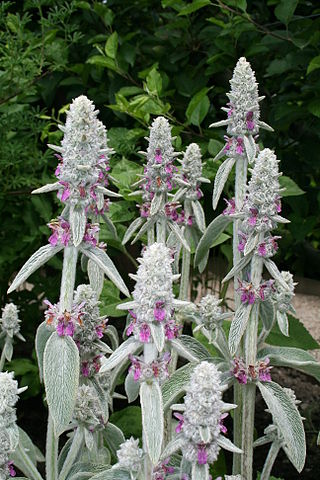
Stachys byzantina, the lamb's-ear or woolly hedgenettle, is a species of flowering plant in the mint family Lamiaceae, native to Armenia, Iran, and Turkey. It is cultivated throughout much of the temperate world as an ornamental plant, and is naturalised in some locations as an escapee from gardens. Plants are very often found under the synonym Stachys lanata or Stachys olympica.

Agastache rugosa, also known as wrinkled giant hyssop, Korean mint, purple giant hyssop, Indian mint and Chinese patchouli is an aromatic herb in the mint family, native to East Asia.
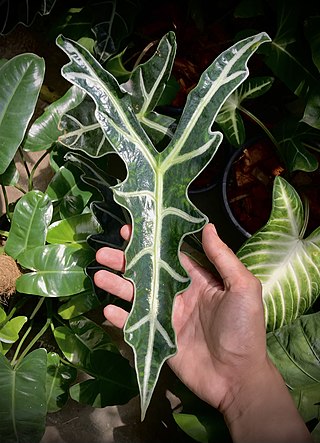
Alocasia sanderiana, commonly known as the kris plant or Sander's alocasia, is a plant in the family Araceae. It is endemic to Northern Mindanao in the Philippines, but is commonly grown as an ornamental plant worldwide. It is classified as critically endangered in the wild by the International Union for Conservation of Nature.
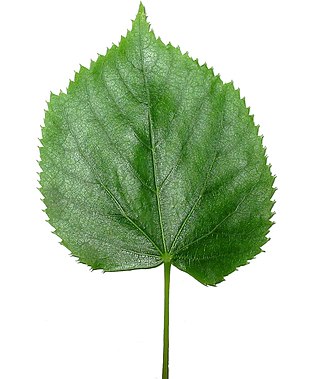
A leaf is a principal appendage of the stem of a vascular plant, usually borne laterally aboveground and specialized for photosynthesis. Leaves are collectively called foliage, as in "autumn foliage", while the leaves, stem, flower, and fruit collectively form the shoot system. In most leaves, the primary photosynthetic tissue is the palisade mesophyll and is located on the upper side of the blade or lamina of the leaf but in some species, including the mature foliage of Eucalyptus, palisade mesophyll is present on both sides and the leaves are said to be isobilateral. Most leaves are flattened and have distinct upper (adaxial) and lower (abaxial) surfaces that differ in color, hairiness, the number of stomata, the amount and structure of epicuticular wax and other features. Leaves are mostly green in color due to the presence of a compound called chlorophyll which is essential for photosynthesis as it absorbs light energy from the sun. A leaf with lighter-colored or white patches or edges is called a variegated leaf.

Cremastobombycia solidaginis is a moth of the family Gracillariidae. It is known from Ontario and Quebec in Canada, and Florida, Texas, Georgia, Kentucky, Maine, Maryland, Massachusetts, Connecticut and Michigan in the United States.

Quoya dilatata is a flowering plant in the mint family Lamiaceae and is endemic to Western Australia. It is a low, spreading shrub with its branches and leaves densely covered with a layer of white, woolly hairs. The leaves are wrinkled or crinkly and the tube-shaped flowers are orange-red and hairy on the outside.
Muniria megalophylla is a flowering plant in the mint family Lamiaceae and is endemic to Arnhem Land in the Northern Territory. It is a shrub with its branches and leaves densely covered with a layer of short, greyish, branched hairs and small groups of reddish-pink flowers near the ends of the branches.

Pityrodia obliqua is a flowering plant in the mint family Lamiaceae and is endemic to the Kimberley region of Western Australia. It is an erect shrub with hairy stems, wrinkled, egg-shaped leaves and pink, bell-like flowers with purple streaks inside.
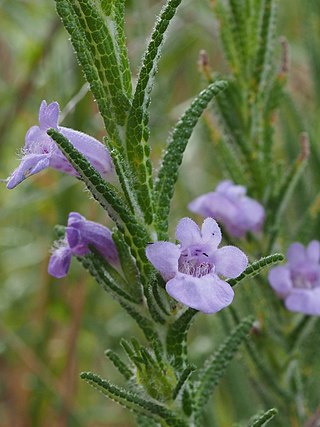
Chloanthes parviflora is a species of flowering plant in the family Lamiaceae. It is a small, rounded shrub with dark green, linear leaves and mauve tubular flowers. It grows in New South Wales and Queensland.
Chloanthes glandulosa is a species of flowering plant in the family Lamiaceae. It is a small shrub with wrinkled leaves and greenish-yellow tubular flowers. It is endemic to New South Wales.

Olearia rugosa, commonly known as wrinkled daisy-bush, is a species of flowering plant in the family Asteraceae. It has alternate, wrinkled leaves and white daisy-like flowers and is endemic to south-eastern Australia.
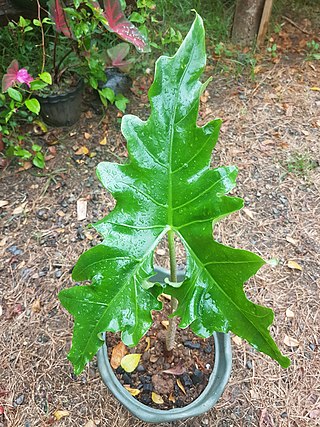
Alocasia nycteris, commonly known as the bat alocasia or the batwing alocasia, is a plant in the family Araceae. It is endemic to island of Panay in the Philippines. It is cultivated as an ornamental plant.
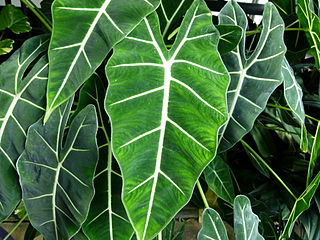
Alocasia micholitziana, commonly known as the green velvet taro or green velvet alocasia, is a plant in the family Araceae. It is endemic to the island of Luzon in the Philippines. It is commonly grown as an ornamental plant worldwide.

Alocasia heterophylla is a plant in the family Araceae. It is endemic to the islands of Luzon, Mindanao, and Polillo in the Philippines.

Babiana lobata is a species of geophyte of 12–25 cm (4.7–9.8 in) high that is assigned to the family Iridaceae. It has leaves that consist of a sheath and a blade that are at a slight angle with each other. The leaf blades are narrow, sword- to lance-shaped and have a left and right surface, rather than an upper and lower surface. The leaf blades are slightly pleated and hairless. The inflorescence contains seven to twelve bluish mauve mirror-symmetrical flowers comprising six tepals, with the lower lateral tepals yellow sometimes flushed mauve at their tips, and with three stamens crowding under the dorsal tepal. Flowering occurs in July and August. The flowers emit a faint acrid-metallic scent. B. lobata grows in part of the Richtersveld in the Northern Cape province of South Africa.
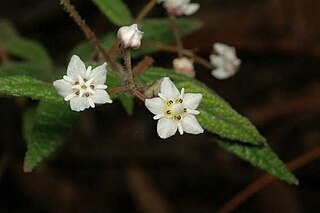
Commersonia rugosa is a species of flowering plant in the family Malvaceae and endemic to New South Wales. It is an open, straggly shrub with linear to narrowly egg-shaped leaves with irregular teeth or lobes on the edges, and white flowers in clusters of 3 to 15.
Schismatoglottis imbakensis is a species of plant that was discovered during a scientific expedition to the Sungai Kangkawat, Imbak Canyon Conservation Area (ICCA), Tongod District, Malaysia, on the island of Borneo. The plant was first described in 2020, during an exhibition led by scientists from the Sabah Foundation and the University of Malaysia Sabah.















